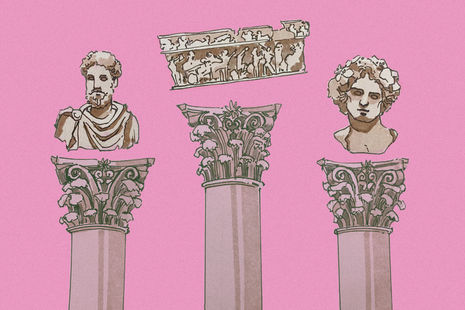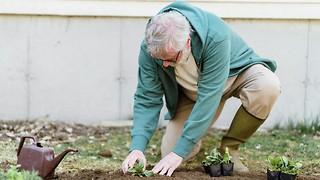The ethics of display in the Fitzwilliam Museum
Holly Higham considers how the layout of museums creates a hierarchy of history

In the words of Brian Sparkes, “Art is a dangerous word”. Art, with a capital A, often brings to mind some elevated concept of aesthetics, value, and delicacy. It is something profound, ideal, transcendent. Of course, art, or Art, can be all of these things, and validly so. But, sometimes, an endorsement of this ideal leads us to abandon alternatives, and important meanings of objects become lost. When one decides to display art, you can either do so in a way that displays it as ‘Art’ or ‘art’. When you place a certain piece in a certain place, you decide which meanings and narratives to draw out, and which to conceal.
As you walk into the Fitzwilliam Museum, you may notice its neoclassical columns, the imposing pediment, the Greek statues peering down at you from above. You may think that it is beautiful, you may think that it is garish, you may only offer it a passing glance. As you descend into the antiquities section, you walk past display cases, peer at objects behind glass, and read descriptions about their providence, use, and significance.
Whether you view these objects aesthetically or pragmatically, what you might forget is that when you step into a museum, the ‘craft’ does not stop at the Black-figure vase you may be investigating. The whole museum is crafted, laid out, and decorated to influence the relationship between object and viewer. The white statues that are the ‘pinnacle of beauty’, deliberately placed on a pedestal for us to unquestioningly gape at, also carry with them problematic ideologies: the white man becomes elevated above all else. Elsewhere, the objects of everyday experience, a drinking cup perhaps, are placed behind glass, becoming an objet d’art instead of a domestic tool.
“When one decides to display art, she can either do so in a way that displays it as ‘Art’ or ‘art’”
The Pashley Sarcophagus is placed in the centre of the Fitz’s antiquities section. This large, ornate, stone object is quite imposing, and perhaps the first thing your eyes may light upon as you walk in. But despite viewing it on multiple occasions, I have often found myself forgetting its purpose. It is raised up, like the Greek statues mentioned, flaunted, beautiful. But it has a more morbid reality: a dead man once rested inside of it. He was a person with a family, friends, a person who lived and died. Its Dionysiac imagery can, of course, tell us about the Eleusinian mysteries, or Bacchic revelry. But can it not also tell us about the priorities and preferences of those who personally chose it, or depicted it?
Of course, our reconstructions of any ancient mindset, attitude, or ideology are limited at best. However, what is not limited is our imagination, sympathy, and humanity: these are three things we would have shared with the real humans involved in choosing, creating, and being buried in such an object. The sarcophagus is beautiful, in my opinion. There is no denial that it is art. But if we narrowly conceive of it as ‘Art’, it loses a dimension of its reality, a dimension of functionality and sentimentality. The prioritisation of aesthetics leads to blind-spots.
It is not just the display of singular objects that constructs narratives. It is the way in which we choose to lay out whole museums and collections. As Christopher Whitehead points out, “it might be argued that to display is to theorise- about the world, the past, about relations between objects and events”. When you enter the lower galleries at the Fitz, you simply cannot avoid the antiquities section. On the other hand, you may have to go looking for their collection focusing on Ancient Sudan. Now, of course, to make such a comparison is not so straight-forward. Many factors contribute to the Fitz having more objects from the ancient Mediterranean: its vast scale, time period, production and output, and the (often problematic) prioritisation of its study in history.
“The scattered approach to display can create a new path within the museum, one that may sidestep the antiquities section and leave it for later”
This is, however, not the point. The point is that the front-and-centre position of the artefacts from Greece and Italy implicitly pushes the narrative that these regions and periods are the ‘most important’. In doing so, this restricts access to and engagement with other equally-as interesting and important times and places, just like Ancient Sudan. We should not stop studying or displaying artefacts from Greece and Rome, and as a Classicist, I am the last person who would want that. But we should bring other cultures, time periods, and people along with it. The fact is that the side rooms and nooks we encounter at the Fitz ought not be sidelined, but integrated with enthusiasm.
The Fitz has begun to explore such questions itself. In a recent exhibition, ‘Glenn Ligon: All Over the Place’, text-based paintings were scattered throughout the museum, rather than being assigned a certain room. Ligon described the exhibition as a "thread that winds its way through the Fitzwilliam, loose in some places, taut in others, which the visitor can choose to follow or encounter serendipitously." I think this speaks to the necessity of re-thinking the linear, to start deconstructing not just museums, but museological practice itself. Ligon questions the "layers of history and meaning" in the Fitz, not just in a single, boxed-off space, but throughout the whole museum. The issues Ligon speaks on are continuous, like a thread, and are intertwined with every object we set our eyes upon. The scattered approach to display can create a new path within the museum, one that may sidestep the antiquities section and leave it for later, one that leads us down not just a literal path on a visit, but a path through time and ideas. This path can open up a whole new perspective on the objects we see, the layout of the museum, and the institution of ‘The Modern Museum’ itself.
All museums are all implicated in the ethics of display. They now have a responsibility to not only question their past and present, but to start to form a future where the relationships between objects, their history, and their current viewers, are to become dynamic, fluid, and complicated.
 News / Uni Scout and Guide Club affirms trans inclusion 12 December 2025
News / Uni Scout and Guide Club affirms trans inclusion 12 December 2025 News / Cambridge Vet School gets lifeline year to stay accredited28 November 2025
News / Cambridge Vet School gets lifeline year to stay accredited28 November 2025 Science / Did your ex trip on King’s Parade? The science behind the ‘ick’12 December 2025
Science / Did your ex trip on King’s Parade? The science behind the ‘ick’12 December 2025 News / Cambridge study finds students learn better with notes than AI13 December 2025
News / Cambridge study finds students learn better with notes than AI13 December 2025 News / Pembroke to convert listed office building into accom9 December 2025
News / Pembroke to convert listed office building into accom9 December 2025








